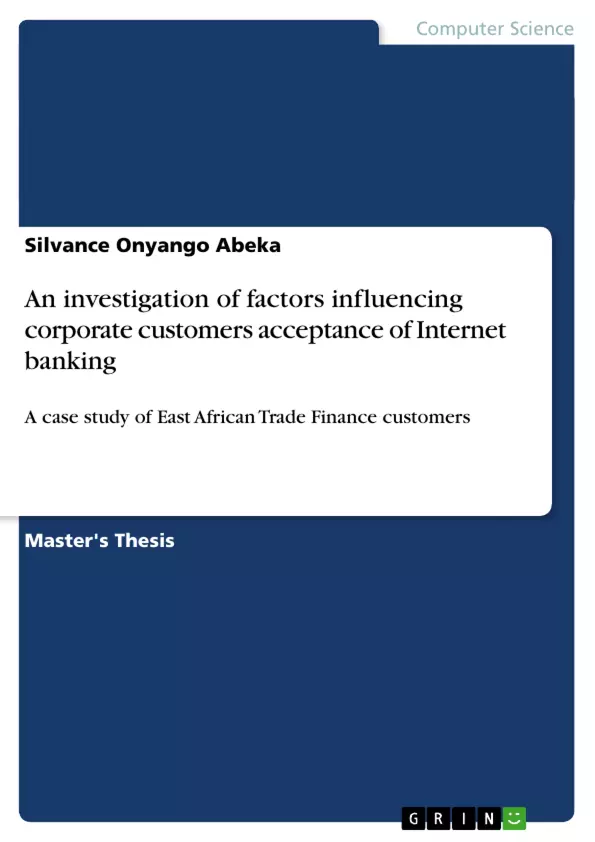It is increasingly more interesting to the bank managers to understand what is important to customers when it comes to Internet banking, and especially banking conducted by the customers themselves. Corporate customers and Internet banking has been studied very modestly in the past, and especially the decision-making factors driving customers to go online.
The purpose of this research is to identify the factors that influence corporate customers adoption of Internet banking services in Kenya, Uganda, Tanzania and Rwanda. The hypotheses are empirically evaluated by using Trade Finance customers of an East African bank as the target sample.
Technology Acceptance Model (TAM) is the primary basis for the study. The information gathered from former studies that are mainly concentrating on private customer acts as a foundation for building an extension of TAM suitable for corporate customers.
Due to the quantitative nature of the study, the results are analysed with statistical measures. The analysis reveals that corporate users are not motivated by the same factors as private users. In order to become Internet banking customers, it is extremely important for corporate users to have a system that is easy to use and operate with full support from the bank.
Inhaltsverzeichnis (Table of Contents)
- Chapter 1: Introduction
- 1.1 Background to the Study
- 1.2 Statement of the Problem
- 1.3 Objectives of the Study
- 1.4 Research Questions
- 1.5 Significance of the Study
- 1.6 Scope of the Study
- 1.7 Limitations of the Study
- 1.8 Definition of Terms
- Chapter 2: Literature Review
- 2.1 Electronic Banking and its Adoption
- 2.2 Factors Influencing Adoption of Electronic Banking
- 2.3 Adoption of Electronic Banking in Africa
- 2.4 Literature on Internet Banking in East Africa
- 2.5 The Theoretical Framework
- Chapter 3: Research Methodology
- 3.1 Research Design
- 3.2 Target Population
- 3.3 Sampling Procedure
- 3.4 Data Collection Techniques
- 3.5 Data Analysis Techniques
- Chapter 4: Data Analysis and Presentation
- 4.1 Descriptive Analysis
- 4.2 Inferential Analysis
- Chapter 5: Summary, Conclusions and Recommendations
Zielsetzung und Themenschwerpunkte (Objectives and Key Themes)
This thesis examines the factors influencing corporate customers’ acceptance of internet banking in East Africa, specifically focusing on trade finance customers. It aims to identify the key drivers and barriers to internet banking adoption in this context.
- Factors influencing corporate customers’ adoption of internet banking
- The role of perceived usefulness, perceived ease of use, and trust in internet banking adoption
- The influence of security concerns and regulatory issues on internet banking adoption
- The impact of cultural and technological factors on internet banking adoption in East Africa
- The relationship between corporate customers’ perceptions and their actual use of internet banking services
Zusammenfassung der Kapitel (Chapter Summaries)
Chapter 1: Introduction provides an overview of the research topic, including background information, the problem statement, objectives, research questions, significance, scope, limitations, and definitions of key terms. This chapter sets the stage for the investigation into the adoption of internet banking by corporate customers in East Africa.
Chapter 2: Literature Review delves into existing research on electronic banking, its adoption, and the factors influencing it. This chapter explores the literature on electronic banking adoption in Africa and specifically focuses on internet banking in East Africa. It also presents the theoretical framework guiding the study.
Chapter 3: Research Methodology outlines the research design, target population, sampling procedure, data collection techniques, and data analysis methods used in the study. This chapter details the methods employed to gather and analyze data relevant to the research questions.
Chapter 4: Data Analysis and Presentation presents the results of the data analysis, including descriptive and inferential analysis. This chapter provides insights into the factors influencing corporate customers' acceptance of internet banking in East Africa.
Schlüsselwörter (Keywords)
Internet banking, corporate customers, trade finance, East Africa, adoption, perceived usefulness, perceived ease of use, trust, security concerns, regulatory issues, cultural factors, technological factors, data analysis.
- Quote paper
- Silvance Onyango Abeka (Author), 2009, An investigation of factors influencing corporate customers acceptance of Internet banking, Munich, GRIN Verlag, https://www.grin.com/document/194928



